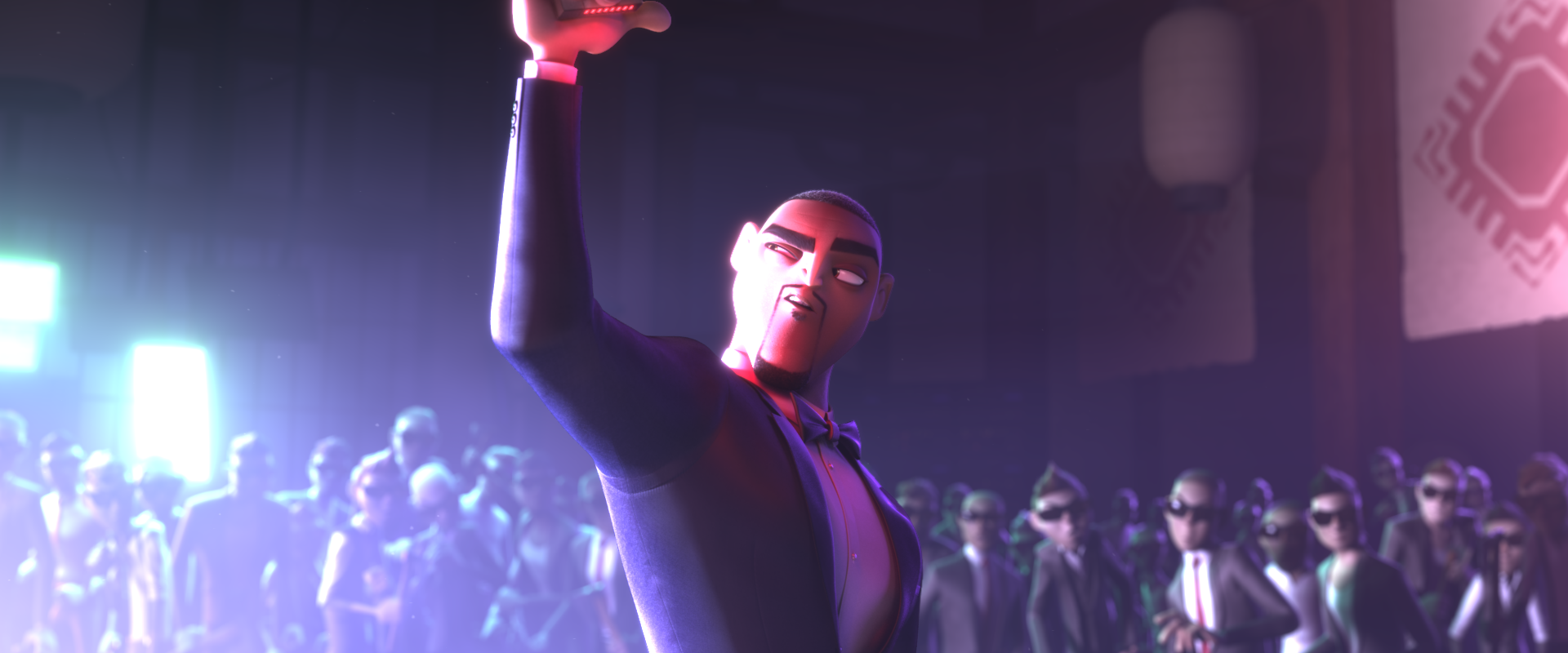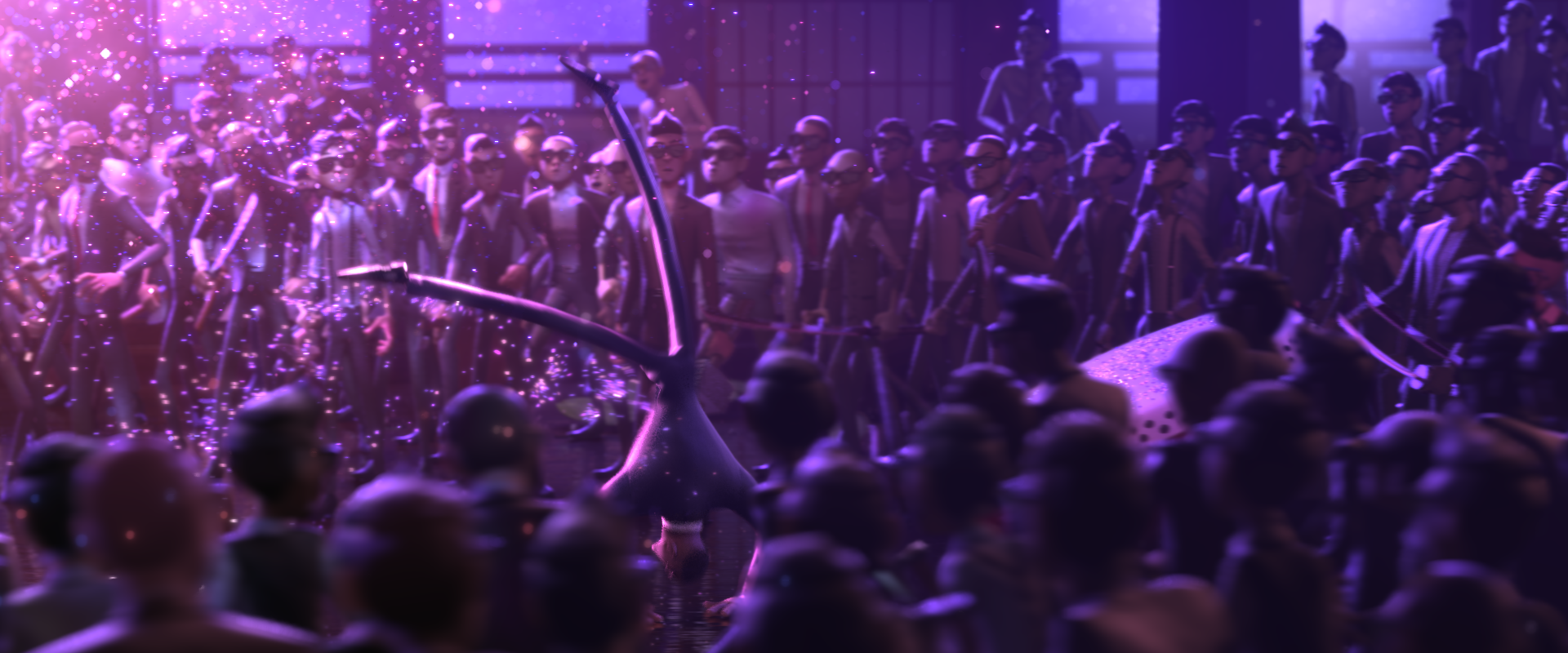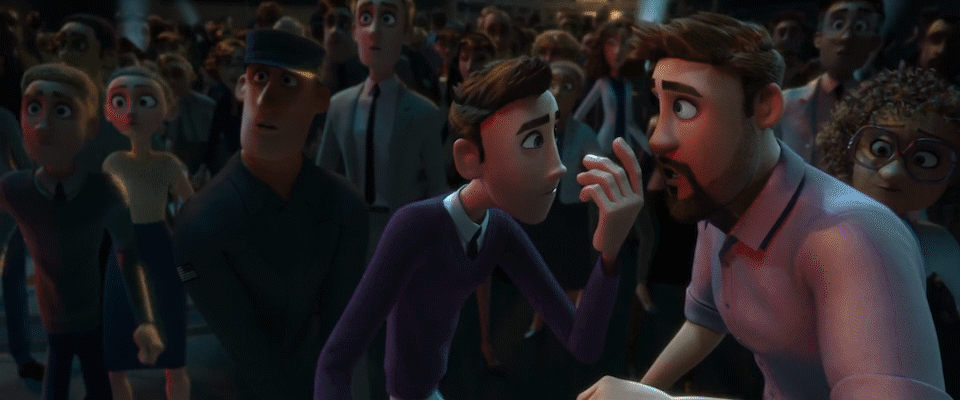
SPIES IN DISGUISE (2019)
Blue Sky Studios - Crowd TD
OVERVIEW
When you work as a crowds artist, over time you get to really know the people you work with. Every studio, and every show, has a cast of background characters that come with their own quirks, attitudes, and sense of style. Some of these characters walk right past the main character and give the camera a knowing look. Some would find out in dailies to both their horror and mine that their supposedly 'unique' hairstyle is shared by at least fifty other people. And there's always that one guy in a bright teal shirt and purple shorts who probably should have changed before going to the office—let alone before he met the in-real-life directors of the movie in a review.
Over 19 months, I got to know the background characters and world of Spies In Disguise significantly. I personally brought thousands of them to life directly as a crowds artist and through my work in the shadows as a programmer. I was fortunate enough to lead the crowds work on two major set-pieces in the movie, to design a lot of tools, and to make a lot of pretty pictures. Read, enjoy, and I'm always happy to talk shop if you have any questions.
Shot Count

WHEN THE BACKGROUND IS THE FOREGROUND
THE YAKUZA
The phrase "same, but different" is an expression you often hear if you work as an artist or designer. Usually, it's a fairly negative way of saying, "I spent extra time on this, but it doesn't look any better, just different." If you work in crowds, "same, but different," takes on a new meaning. Making hundreds of characters that are basically the same seem different from each other is quite the compliment.
I was lucky to be given control over all of the crowds in the Yakuza fight sequence. It was a major challenge to make a limited number of Yakuza variations look "same, but different". How was this done? Each character was placed by hand, and in each shot dozens of alterations were made to the characters. Making right-handed people left-handed, re-animating arms and legs, tweaking head positions, tilting spines, and delicately distributing the limited character variations into the background is the bread and butter of this kind of work. It's a lot like coloring in a map of the world without giving two bordering countries the same color. But when it comes to people, there are many vectors to finding "sameness". Sometimes it's hair, sometimes it's clothes, and other times it's the body type that becomes too “samey". This sequence is one of my favorite examples of getting the most out of a cast of characters who all "look the same".

AGENCY Defense
There is a constant push and pull, ebb and flow, and yin and yang that exists between crowd animation and "hero", or main character, animation. Artistically it's important to match the style and choreography of the "heroes", while at the same time giving the crowd its own uniqueness. If a crowd has no uniqueness, the illusion that they are people breaks, and you see the background characters for the clones that they really are. If they are too unique, they become distracting, and you will more clearly notice their unfavorable similarities.
Near the end of the film, I was made the crowd lead for the Agency Defense sequence which was one of the most challenging in the film. It began by getting the directors to buy off on an exact number of people who should be in the room, which was 225. Then, days were spent laboriously choosing their exact clothing and casting, down to the color of their shoes, the appropriate number of redheads, and the shaving habits of every single man in the room.
I then prepared and blocked each shot, and passed off the work to four other crowds artists who did an amazing job taking what I had started across the finish line. Nothing short of amazing because the crowds are so close to camera that in places they eclipse the "hero" work, and I'm certain you'd never be able to tell where. We key off of animation, and when there are issues they are asked to key off of us: the creative push and pull of our trade.
Cole made the crowds in the banner image. The crowds in these shots were blocked by Cole, but taken to completion by Ben Dupin and Erin Elliott.

THE MANY BEHAVE AS ONE
Drone Squadrons
It doesn't take long before the complexity of making a crowd becomes large enough, or strange enough, to require dedicated programming. You must craft and refine the tools you need as you are using them.
I was handed the responsibility of creating, simulating, lighting, and rendering all 19 of these drone attack shots which were the largest crowd shots in the movie. After pitching over 20 different designs, the directors decided that they wanted an intimidating cloud roiling with squadrons of drones.
To realize their vision, I started by spending a lot of time programming a special crowd instancer to handle these squadrons in a way that was precise and efficient. Then, the squadrons were placed above the Reflecting Pool, and the tough work of layering dozens of little nuances into each shot began. This kind of work is incredibly subtle and thankless, but if you have enough time and if you add in just the right things, you start getting frames that look really awesome.
To do good crowd work is to give yourself a working environment where you can easily switch between animating the individual, the group, and the whole. It is in that space that crowd shots are really fun.
Cole was responsible for the drones. Cole blocked the human crowds, but they were taken to completion by Ben Dupin.

PIGEONS TAKE FLIGHT
What does it mean for a crowd to “act” when every living thing has its own motivations, thoughts, and feelings? Some crowds give a selfish performance, as if each person in them was told to “do their own thing”. But sometimes, something dramatic happens in a shot, and despite their differences, the entire crowd has the same reaction. When a school fire alarm goes off, a soccer player scores a goal, or the gate to a theme park opens, people very easily lose their individuality.
In the Piazza San Marco sequence, I was responsible for developing the simulation setup for the pigeons. They had to be able to perform, take off, fly, land, and then perform again, as the main character rolled in on a Vespa. I did this by creating a special curve generator that each pigeon would reference as they flew. The curves could then be sculpted by painting the ground beneath the pigeons, with the amount “red paint” determining the arc of the path that they would fly, and “green paint” determining the direction that they would fly in.
A fun fact about pigeons I learned from co-director Nick Bruno: it takes a lot of energy for a pigeon to take flight, so they are by nature a little lazy and only fly out of the way when absolutely necessary. Therefore, in each shot either the pigeons are minding their own business, sleeping or looking for food, or, when in danger, they rise up and behave as one.
These shots were directly executed by Cole
Cole developed the pigeon takeoff and landing system, but these shots were executed by Mason Evans and Ben Dupin

AND TOGETHER THEY FALL
Drone Collapse
A wall hit, a ricochet, a slide, and a flickering light; it's fun to flip the off switch and let gravity do its thing. The little moments really make a sim come to life, and to make them happen it's important to be able to negotiate with the talented people around you when you need help.
I showed one specific drone hitting the wall three times for review before I was happy. My producer let me spend some OT jamming a drone through the metal detector in the perfect way. I tested, and then got permission from a CG supervisor to slide a drone in front of the hand-animated "hero" drones. Upon request, I made special “light flickering” passes of the drones so that the flickering specifically could be reviewed easily. A fellow TD, Mason Evans, wrote the actual render-time light instancing code. I convinced the FX team to add a shatter effect as the drones crashed through the glass barrier, but we only had the budget to do it once, so it was important to pick the coolest possible moment to use up our "break the glass" money.
So much time, discussion, and coordination goes into making these shots. It's messy, but it's so satisfying when it all comes together. The directors approved these shots immediately after the first time they saw them.

CARTOONY RAGDOLLS
Most little shots are forgettable technical and artistic hand-me-downs from the bigger shots. But sometimes, a little shot is special, and weeks are spent working on something that barely lasts longer than a second.
A shocking amount of work went into creating the ragdolls (falling people) for these three tiny shots. Cartoony ragdolls are especially challenging because their movement needs to be very tightly controlled and exaggerated. To do this, I made a custom simulation rig where a "marionette" was linked to each character and then laboriously animated to pull the ragdolls in the perfect way. I discovered while polishing the shot that if I had the exact right frame to start pulling on one specific ragdoll, with the perfect frame for dropping his baton, the baton did a neat little flip at the bottom of frame that wouldn't happen in any other way.
By the end, you watch shots like these a thousand times on loop, it's scratch audio burns into your soul, and honestly you lose a little perspective on what really matters. But in a way, losing perspective while making something small look really good is part of the fun.

SIGGRAPH 2020
By sheer coincidence, the marketing team picked a shot I made the crowds for.
Technical Details
I co-authored a SIGGRAPH paper about the crowds of Spies in Disguise with Erin Elliott, Mason Evans, and Will Moten. In it, we discuss some of the fine technical details about the tools we wrote for the film.
My particular contributions are briefly explained in section 2.1 about CC Place, which was our main crowd placement system used for the majority of the film. Feel free to take a gander at the paper, which is distributed for free by ACM, at the link below:


































